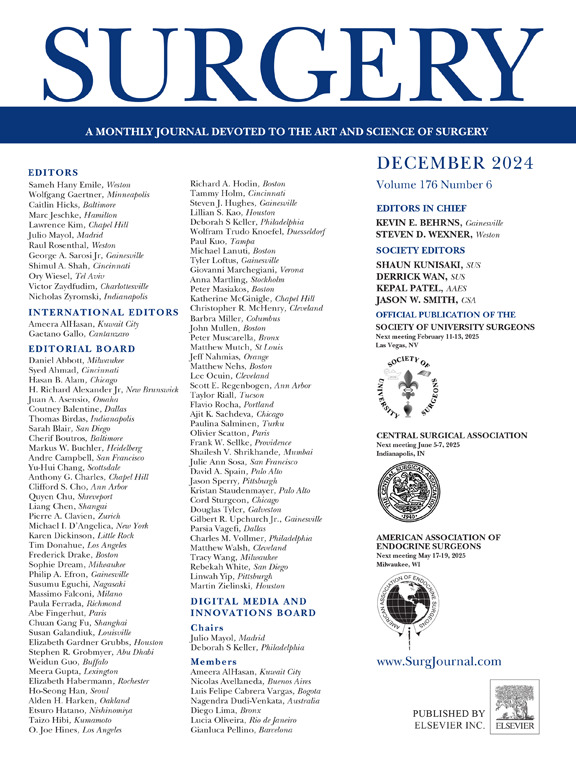Is there a place for laparoscopic reoperation for complications after minimally invasive pancreatectomy?
IF 3.2
2区 医学
Q1 SURGERY
引用次数: 0
Abstract
Introduction
Although the use of the minimally invasive approach is expanding in pancreatic surgery, indications and results of laparoscopic reinterventions after pancreatectomy are unknown.
Methods
Based on the multicenter AFC (Association Française de Chirurgie) cohort (2010–2021), patients who underwent open (open reoperation group) or laparoscopic (laparoscopic reoperation group) reoperation within 90 days after minimally invasive pancreatectomy were included and compared. Inverse probability of treatment weighting analysis was performed to determine the impact of laparoscopic reoperation on postoperative mortality.
Results
Of the 3,412 patients who underwent minimally invasive pancreatectomy, 298 (8.7%) underwent reoperation, with a median delay of 9 days (interquartile range: 4–19 days). Most frequent causes of reintervention were pancreatic fistula with uncontrolled sepsis (postoperative pancreatic fistula) (23%) and hemorrhage (postpancreatectomy hemorrhage) (46%). Sixty-five patients (22%) underwent laparoscopic and 233 (78%) open reoperation. Laparoscopic reoperation was mostly performed for postoperative pancreatic fistula drainage (43%), postpancreatectomy hemorrhage (26%), bowel obstruction (20%), or peritonitis (8%). Patients in the laparoscopic reoperation group were more often reoperated on after distal pancreatectomy (54% vs 36% in open reoperation group, P = .017). After pancreatoduodenectomy, laparoscopic reoperation was more often performed for bowel obstruction compared with open reoperation (20% vs 4%, P = .005). After reintervention, the postoperative mortality rate was 13%. Hospital stay was significantly shorter after laparoscopic reoperation (28 vs 36 days, P = .037). After adjustment for inverse probability of treatment weighting, laparoscopic revision was statistically associated with less postoperative mortality (odds ratio = 0.81, 95% confidence interval: 0.81–0.95).
Conclusion
The laparoscopic approach may be an option for surgical reintervention after minimal invasive pancreatectomy in non–life-threatening indications, mainly after distal pancreatectomy for postoperative pancreatic fistula drainage or after pancreatoduodenectomy for occlusion.
微创胰切除术后并发症是否有腹腔镜再手术的余地?
虽然微创入路在胰腺手术中的应用正在扩大,但胰切除术后腹腔镜再介入手术的适应症和结果尚不清楚。方法基于多中心AFC (Association franaise de Chirurgie)队列(2010-2021),纳入微创胰腺切除术后90天内接受开放(开放再手术组)或腹腔镜(腹腔镜再手术组)再手术的患者并进行比较。采用治疗加权逆概率分析确定腹腔镜再手术对术后死亡率的影响。结果在3,412例行微创胰腺切除术的患者中,298例(8.7%)再次手术,中位延迟9天(四分位数间距:4-19天)。再干预最常见的原因是胰瘘合并脓毒症(术后胰瘘)(23%)和出血(胰腺切除术后出血)(46%)。65例(22%)接受腹腔镜手术,233例(78%)再次开放手术。腹腔镜下再手术多为术后胰瘘引流(43%)、胰切除术后出血(26%)、肠梗阻(20%)或腹膜炎(8%)。腹腔镜下再手术组患者远端胰腺切除术后再手术的发生率更高(54% vs .开放式再手术组36%,P = 0.017)。胰十二指肠切除术后,腹腔镜下再手术治疗肠梗阻的比例高于开放式再手术(20% vs 4%, P = 0.005)。再干预后,术后死亡率为13%。腹腔镜再手术患者住院时间明显缩短(28天vs 36天,P = 0.037)。调整治疗加权逆概率后,腹腔镜翻修与较低的术后死亡率有统计学相关性(优势比= 0.81,95%可信区间:0.81 - 0.95)。结论在微创胰切除术后无生命危险的情况下,腹腔镜入路可作为微创胰切除术后再介入手术的选择,主要是在远端胰切除术后胰瘘引流或胰十二指肠切除术后闭塞。
本文章由计算机程序翻译,如有差异,请以英文原文为准。
求助全文
约1分钟内获得全文
求助全文
来源期刊

Surgery
医学-外科
CiteScore
5.40
自引率
5.30%
发文量
687
审稿时长
64 days
期刊介绍:
For 66 years, Surgery has published practical, authoritative information about procedures, clinical advances, and major trends shaping general surgery. Each issue features original scientific contributions and clinical reports. Peer-reviewed articles cover topics in oncology, trauma, gastrointestinal, vascular, and transplantation surgery. The journal also publishes papers from the meetings of its sponsoring societies, the Society of University Surgeons, the Central Surgical Association, and the American Association of Endocrine Surgeons.
 求助内容:
求助内容: 应助结果提醒方式:
应助结果提醒方式:


